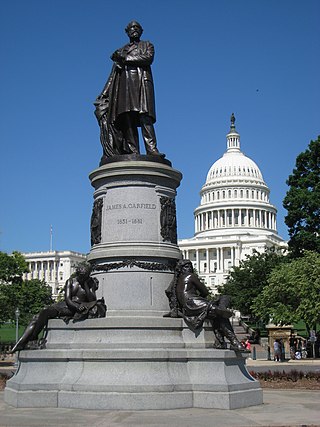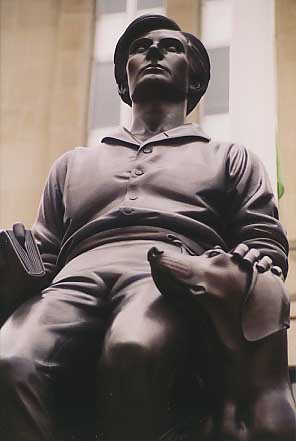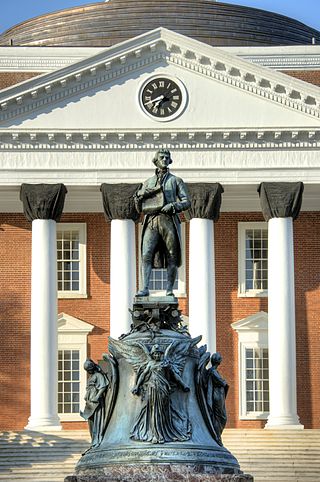

The Jefferson Monument is a statue by Moses Jacob Ezekiel located outside the Louisville Metro Hall in Louisville, Kentucky, US. [1]


The Jefferson Monument is a statue by Moses Jacob Ezekiel located outside the Louisville Metro Hall in Louisville, Kentucky, US. [1]
The monument to Founding Father Thomas Jefferson was created in 1899 by Sir Moses Ezekiel. It was commissioned as one of two sculptures for the exterior of the Jefferson County Courthouse; the other statue honors Louis XIV. [2]
The Jefferson statue was presented to the city of Louisville by the Bernheim Brothers, two wealthy, public-spirited businessmen of the city, in November 1901. It was unveiled at ceremonies that included addresses by former Governor of Kentucky William O'Connell Bradley and Mayor Charles P. Weaver. It stands on Jefferson street in front of the Jefferson County Court House, the architecture of the later forming an effective background. [3]
The status of Jefferson is in bronze, 9 feet (2.7 m) high, and represents him at the age of 33 presenting the Declaration of Independence to the First Congress. The subject is well conceived and executed with power and artistic taste. An original feature is the bronze pedestal, which represents the famous Liberty Bell, the height being 9 feet (2.7 m) with a diameter of nearly 10 feet (3.0 m). On the outside of this bell at four equidistant points are modeled figures, representing Liberty, Equality, Justice and the Brotherhood of Man. The statue symbolizing Liberty shows the Goddess of Liberty starting forward bursting the chains from her arms. She occupies the front of the pedestal and the flowing drapery and vigorous motion of the figure are incisively portrayed. Justice, with bandaged eyes, is shown with drawn sword in one and hand and scales in the other. Equality is typified in female form, represented in the act of casting from her the law of primo-geniture, and treading underfoot the 1765 Stamp Act. [3]
The lower part of the monument is of dark Quincy granite from the Quincy Granite Quarries in Quincy, Massachusetts, all parts highly polished, the die block being 10 square feet (0.93 m2) and 5 feet (1.5 m) high resting on steps or bases laid in sections, the lowest of which is 19 feet (5.8 m) square. The whole is 25 feet (7.6 m) high. Clarke & Loomis of Louisville were the constructing architects, and the bronze was cast in Berlin, Germany. The sculptor is Sir Moses Ezekiel, who designed the granite pedestal and executed the models for statuary at his studio in Rome. [3]

A smaller replica of the monument stands at the University of Virginia, which Jefferson founded in 1819. [4]

Moses Jacob Ezekiel, also known as Moses "Ritter von" Ezekiel, was an American sculptor who lived and worked in Rome for the majority of his career. Ezekiel was "the first American-born Jewish artist to receive international acclaim". Ezekiel was an ardent supporter, in both his writings and in his works, of the Lost Cause revisionist view of history.

The Soldiers and Sailors Monument is a monument erected in Boston Common in downtown Boston, dedicated to soldiers and sailors of the Commonwealth of Massachusetts who died in the American Civil War. Designed by Martin Milmore, construction began in 1874 and the monument was dedicated on September 17, 1877. Union Generals George B. McClellan and Joseph Hooker were among the estimated 25,000 people attending the dedication on Boston Common.
The Albert Einstein Memorial is a monumental bronze statue by sculptor Robert Berks, depicting Albert Einstein seated with manuscript papers in hand. It is located in central Washington, D.C., United States, in a grove of trees at the southwest corner of the grounds of the National Academy of Sciences at 2101 Constitution Avenue N.W., near the Vietnam Veterans Memorial. Two replicas exist at the Israel Academy of Sciences and Humanities and the Georgia Institute of Technology.

The James A. Garfield Monument stands on the grounds of the United States Capitol in the traffic circle at First Street and Maryland Avenue SW in Washington, D.C. It is a memorial to U.S. President James A. Garfield, who was elected in 1880 and assassinated in 1881 after serving only four months of his term. The perpetrator was an attorney and disgruntled office-seeker named Charles J. Guiteau. Garfield lived for several weeks after the shooting, but eventually succumbed to his injuries. The monument is part of a three-part sculptural group near the Capitol Reflecting Pool, including the Peace Monument and the Ulysses S. Grant Memorial in Union Square. The monument is also a contributing property to the National Mall and L'Enfant Plan, both of which are listed on the National Register of Historic Places and the District of Columbia Inventory of Historic Sites. The bronze statue rests on a granite pedestal that features three sculptures, each one representing a time period in Garfield's life.

The Monument to Nicholas I is a bronze equestrian monument of Nicholas I of Russia on St Isaac's Square in Saint Petersburg, Russia. It was created by French sculptor Auguste de Montferrand and unveiled on July 7 [O.S. June 25] , 1859, the six-meter statue was considered a technical wonder at the time of its creation. It is one of only a few bronze statues with only two support points.

The Confederate Monument in Owensboro, Ky., was a 16-foot-tall, two-part object — a 7-foot-tall bronze sculpture atop a 9-foot-tall granite pedestal — located at the southwest corner of the Daviess County Courthouse lawn, at the intersection of Third and Frederica Streets, in Owensboro, Kentucky. Nearly 122 years after the monument was dedicated in September 1900, the monument was dismantled in 2022, beginning with the removal of the sculpture in May 2022; the sculpture was placed in storage, pending a decision on what to do with it.

The Confederate Memorial in Nicholasville is a historic statue created in the Jim Crow era and located on the Jessamine County courthouse lawn in Nicholasville, Kentucky, ten miles south of Lexington, Kentucky.

The Thomas A. Hendricks Monument is a public artwork by American artist Richard Henry Park and is located on the southeast corner of the Indiana Statehouse grounds in Indianapolis, Indiana. The monument is a tribute to Thomas A. Hendricks, the 21st Vice President of the United States. Hendricks was a former U.S. Representative and U.S. Senator from Indiana. He was the 16th Governor of Indiana and led the campaign to build the Indiana Statehouse.

Major General George Henry Thomas, also known as the Thomas Circle Monument, is an equestrian sculpture in Washington, D.C. that honors Civil War general George Henry Thomas. The monument is located in the center of Thomas Circle, on the border of the downtown and Logan Circle neighborhoods. It was sculpted by John Quincy Adams Ward, best known for his work on the statue of George Washington in Wall Street, Manhattan. Attendees at the dedication in 1879 included President Rutherford B. Hayes, Generals Irvin McDowell, Philip Sheridan, and William Tecumseh Sherman, senators and thousands of soldiers.

Abraham Lincoln, The Hoosier Youth is a heroic bronze sculpture by American artist Paul Manship and was commissioned in 1928 by the Lincoln National Life Insurance Company for its headquarters in Fort Wayne, Indiana. The statue is 12.5 feet (3.8 m) tall and sits atop a pedestal designed by architect Benjamin Wistar Morris and a granite base. The sculpture depicts a youthful Abraham Lincoln during the time he lived in Indiana. The Lincoln figure wears a handmade shirt, buckskin trousers, and boots. He is seated on a tree stump and holds a book. An ax leans against his leg and a dog is seated beside him. Manship also sculpted four bronze allegorical bas reliefs, one for each side of the pedestal, to represent traits associated with Lincoln: Charity, Fortitude, Justice and Patriotism. The statue was dedicated on 16 September 1932.
Anne Whitney created two public statues of Samuel Adams. One, made in 1876, resides in the National Statuary Hall Collection in the US Capitol, Washington, D.C. The other, made in 1880, is located in front of Faneuil Hall Plaza in Boston.

Thomas Jefferson is a statue of U.S. Founding Father and president Thomas Jefferson in front of the Rotunda at the University of Virginia, the university he founded and designed. The statue was crafted by Moses Ezekiel in 1910 and was a copy of the Jefferson statue in Louisville, Kentucky.

An equestrian statue of William Henry Harrison stands in Cincinnati's Piatt Park, in the United States. The monumental statue was designed by sculptor Louis Rebisso and was unveiled on Decoration Day, 1896.

The Ulysses S. Grant Monument is a presidential memorial in Chicago, honoring American Civil War general and 18th president of the United States, Ulysses S. Grant. Located in Lincoln Park, the statue was commissioned shortly after the president's death in 1885 and was completed in 1891. Several artists submitted sketches, and Louis Rebisso was selected to design the statue, with a granite pedestal suggested by William Le Baron Jenney. At the time of its completion, the monument was the largest bronze statue cast in the United States, and over 250,000 people were present at the dedication.

General Israel Putnam is a monumental statue in Hartford, Connecticut, United States. Located in the city's Bushnell Park, the statue was designed by sculptor John Quincy Adams Ward and honors Israel Putnam, a military officer in the Continental Army during the American Revolutionary War. The statue was largely paid for by a donation from judge Joseph P. Allyn and was dedicated in a large ceremony in 1874. It was one of the first statues to be erected in the park, which nowadays houses several other monuments to famous Connecticut residents. From an artistic standpoint, the statue has received mixed reviews from critics.

Dr. Horace Wells, also known as the Horace Wells Monument, is a monumental statue in Hartford, Connecticut, United States. The statue, located in the city's Bushnell Park, was designed by sculptor Truman Howe Bartlett and dedicated in 1875 in honor of Horace Wells, a dentist who was a pioneer in the use of anesthesia.

General Alexander Macomb is a monumental statue in Detroit, Michigan, United States. It was designed by sculptor Adolph Alexander Weinman, was dedicated in 1908 in honor of Alexander Macomb, a Detroit native who had served as the Commanding General of the United States Army for several years in the early 1800s. The monument, which consists of the bronze statue of Macomb standing atop a granite pedestal on a circular concrete platform, was dedicated on September 11, on the anniversary of the Battle of Plattsburgh, a War of 1812 battle that Macomb had participated in. Since the 2010s, the statue has come under criticism due to Macomb's connections to slavery and the mistreatment of Native Americans, with several news sources publishing opinion pieces calling for the statue's removal. During the George Floyd protests in 2020, the monument was vandalized several times.

Stevens T. Mason, also known as the Stevens T. Mason Monument, is a monumental statue in Detroit, Michigan, United States. The monument was designed by sculptor Albert Weinert and architect H. Van Buren Magonigle in honor of Stevens T. Mason, who had served as the first governor of Michigan in the mid-1800s and is notable for being the youngest person to ever serve as the governor of a U.S. state. Mason's remains are interred underneath the monument, which is located in Capitol Park, the site of the former state capitol building. The monument was dedicated on Memorial Day 1908.

Major General David McMurtrie Gregg is a monumental statue located in Reading, Pennsylvania, United States. The monument was designed by Henry Augustus Lukeman and consists of an equestrian statue depicting David McMurtrie Gregg, a military officer who had served in the Union Army during the American Civil War. The monument was dedicated in 1922, several years after Gregg's death in Reading in 1916.